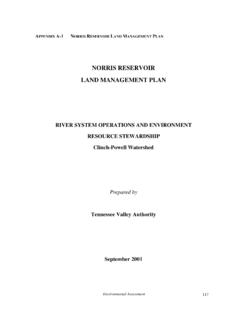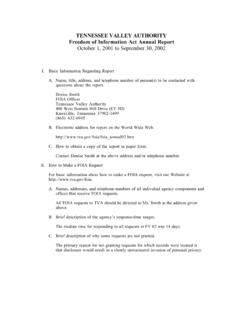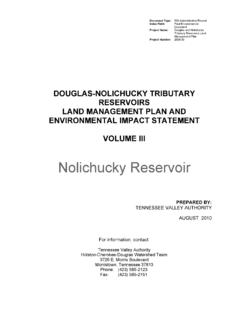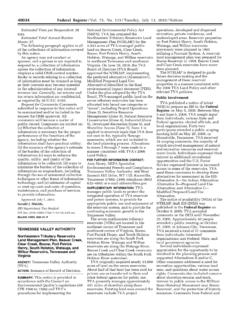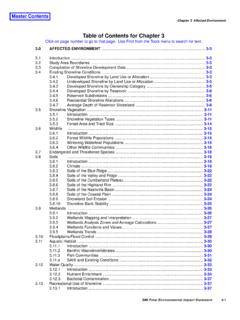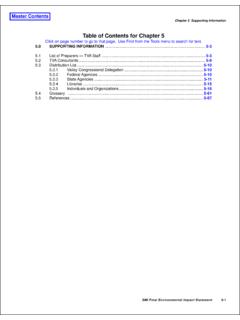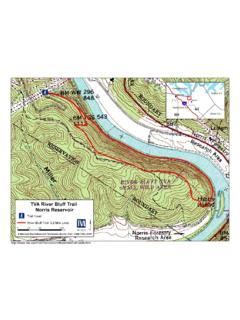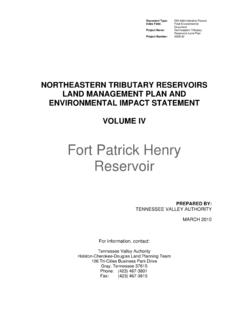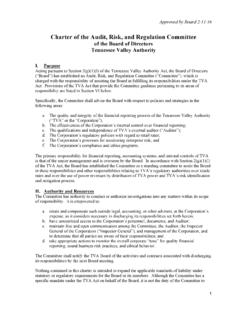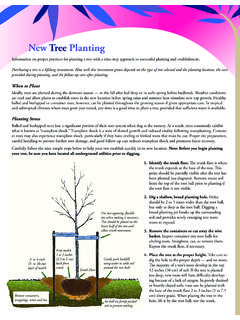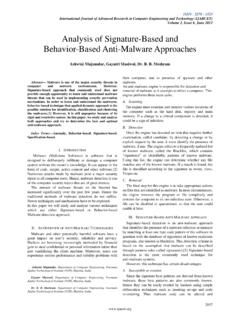Transcription of Appendix V – Site Clearing and Grading …
1 tennessee valley authority site Clearing and Grading Specifications 1. General - The project manager with the Clearing and/or Grading contractor(s) shall review the environmental evaluation documents for the project or proposed activity (categorical exclusion checklist, environmental assessment, or environmental impact statement) along with all Clearing and construction appendices, conditions in applicable general and/or site -specific permits, the storm water pollution prevention plan, open burning or demolition notification requirements, and any tennessee valley authority (TVA) commitments to property owners. The contractor shall then plan and carry out operations using techniques consistent with good engineering and storm water management practices as outlined in TVA s best management practices (BMPs) manual. The contractor will protect areas that are to be left unaffected by access or Clearing work at and adjacent to all work sites. In sensitive areas and their buffers, the contractor will retain as much native ground cover and other vegetation as possible.
2 BMPs shall be installed before general site Clearing or Grading , with progressive stabilization BMPs applied from the perimeter toward the interior work areas as Grading is completed. Any stabilized area that must be disturbed in subsequent steps shall have temporary BMPs installed until work is completed and the area is restabilized. If the contractor fails to use BMPs or to follow environmental expectations discussed in the prebid, prework meeting or present in contract specifications, TVA will order corrective changes and additional work, as deemed necessary in TVA's judgment, to meet the intent of environmental laws and regulations or other guidelines. Major violations or continued minor violations will result in work suspension until correction of the situation is achieved or other remedial action is taken at the contractor s expense. Penalty clauses may be invoked as appropriate. 2. Regulations - The Clearing contractor shall comply with all applicable federal, state, and local environmental and antipollution laws, regulations, and ordinances, including without limitation, all air, water, solid and hazardous waste, noise, and nuisance laws, regulations, and ordinances.
3 He or she shall secure, or ensure that TVA has secured, all necessary permits and authorizations and made all appropriate notifications to conduct work on the acres shown on the drawings and plan and profile for the contract. The contractor s designated project manager will actively seek to prevent, control, monitor, and safely abate all commonly recognized forms of workplace and environmental pollution. Permits or authorizations and any necessary certifications of trained employees knowledgeable of environmental requirements shall be documented with copies submitted to TVA's project manager or environmental specialist before work begins. The contractor and subcontractors will be responsible for meeting all conditions specified in permits. Permit conditions shall be reviewed in prework discussions. 3. Land and Landscape Preservation - The contractor shall exercise care to preserve the condition of cleared soils by avoiding as much compacting and deep scarring as possible in areas not to be developed for buildings, structures, or foundations.
4 As soon as possible after initial disturbance of the soil and in accordance with any permit(s) or other state or local environmental regulatory requirements, cover material shall be placed to prevent erosion and sedimentation of water bodies or conveyances to surface water or groundwater. The placement of erosion/sediment controls shall begin at the perimeter and work progressively to the interior of the site . Repeated work in an area will require establishment of a ground cover immediately after each disturbance is completed. In areas outside the Clearing , borrow, fill, or use and access areas, the natural vegetation shall be protected from damage. The contractor and his or her employees and subcontractors must not deviate from delineated access routes or use areas and must enter the site (s) at designated areas that will be marked. Clearing operations shall be conducted to prevent any unnecessary destruction, scarring, or defacing of the remaining natural vegetation and adjacent surroundings in the vicinity of the work.
5 In sensitive public or environmental areas, appropriate buffer zones shall be observed by modifying the methods of Clearing or reclearing, Grading , borrow, or fill so that the buffer and sensitive area are protected. Some areas may require planting native low-growing plants or grasses to meet the criteria of regulatory agencies, executive orders, or commitments to special program interests. 4. Streamside Management Zones - The Clearing and/or Grading contractor(s) must leave as many rooted ground cover plants as possible in buffer zones along streams and other bodies of water or wet-weather conveyances thereto. In such streamside management zones (SMZs), tall-growing tree species (trees that would interfere with TVA s National Electrical Safety Code clearances) shall be cut, and the stumps may be treated to prevent resprouting. Low-growing trees identified by TVA as marginal electrical clearance problems may be cut and then the stump treated with growth regulators to allow low, slow-growing canopy development and active root growth.
6 Only approved herbicides shall be used, and herbicide application shall be conducted by certified applicators from the Transmission Operations and Maintenance (TOM) organization after initial Clearing and construction. Cutting of trees within SMZs must be accomplished by using either hand-held equipment or other appropriate Clearing equipment, such as a feller-buncher. The method will be selected based on site -specific conditions and topography to minimize soil disturbance and impacts to the SMZ and surrounding area. Disturbed soils in SMZs must be stabilized by appropriate methods immediately after the access or site is cleared. Stabilization must occur within the time frame specified in applicable storm water permits or regulations. Stumps within SMZs may be cut close to the ground but must not be removed or uprooted. Trees, limbs, and debris shall be prevented from falling into water bodies or immediately removed from streams, ditches, ponds, and wet areas using methods that will minimize dragging or scarring the banks or stream bottom.
7 No debris will be left in the water or watercourse. Equipment will cross streams, ditches, or wet areas only at locations designated by TVA after the application of appropriate erosion-control BMPs and consistent with permit conditions or regulatory requirements. 5. Wetlands - In forested wetlands, tall trees will be cut near the ground, leaving stumps and roots in place. The cambium may be treated with herbicides applied by certified applicators from the TOM organization to prevent regrowth. Understory trees that must be initially cut and removed may be allowed to grow back or may be treated with tree growth regulators selectively to slow growth and increase the reclearing cycle. The decision will be situationally made based on existing ground cover, wetland type, and tree species, since tall tree removal may release understory species and allow them to quickly grow to electrical clearance problem heights. In many circumstances, herbicides labeled for water and wetland use may be used in reclearing.
8 At substation, switching stations, and communications sites, wetlands are avoided unless there is no feasible alternative. 6. Sensitive Area Preservation - If prehistoric or historic artifacts or features that might be of archaeological or historical significance are discovered during Clearing , Grading , borrow, or fill operations, the activity shall immediately cease within a 100-foot radius, and a TVA project manager, an environmental specialist, and the TVA Cultural Resources program manager shall be notified. The site shall be protected and left as found until a determination about the resources, their significance, and site treatment is made by TVA's Cultural Resources Program. Work may continue beyond the finding zone and the 100-foot radius beyond its perimeter. 7. Water Quality Control - The contractor s Clearing , Grading , borrow and fill, and/or disposal activities shall be performed using BMPs that will prevent erosion and entrance of spillage, contaminants, debris, and other pollutants or objectionable materials into drainageways, surface waters, or groundwater.
9 Special care shall be exercised in refueling equipment to prevent spills. Fueling areas shall be remote from any sinkhole, crevice, stream, or other water body. Open burning debris shall be kept away from streams and ditches and shall be incorporated into the soil. Only materials allowed to be burned under an open burning permit may be incorporated into the soil. The Clearing and Grading contractor(s) and subcontractors will erect and (when TVA or contract construction personnel are unable) maintain BMPs, such as silt fences, on steep slopes and adjacent to any steam, wetland, or other water body. BMPs will be inspected by the TVA field engineer or other designated TVA or contractor personnel routinely and at least as frequently as required by the permit or good management practices and during periods of high runoff; any necessary repairs will be made as soon as practicable. BMP runoff sampling will be conducted in accordance with permit requirements. Records of all inspections and sampling will be maintained on site , and copies of inspection forms and sampling results will be forwarded to the TVA environmental specialist.
10 8. Turbidity and Blocking of Streams - If temporary Clearing , Grading , borrow, or fill activities must interrupt natural drainage, appropriate drainage facilities and erosion/sediment controls shall be provided to avoid erosion and siltation of streams and other water bodies or water conveyances. In tennessee , conditions of an Aquatic Resource Alteration Permit shall be met. Turbidity levels in receiving waters or at storm water discharge points shall be monitored, documented, and reported if required by the applicable permit. Erosion and sediment control measures such as silt fences, water bars, and sediment traps shall be installed as soon as practicable after initial access, site , borrow, fill, or right-of-way disturbance and after sequential disturbance of stabilized areas due to stepwise construction requirement in accordance with applicable permit or regulatory requirements. On rights-of-way, mechanized equipment shall not be operated in flowing water except when approved and then only to construct necessary stream crossings under direct guidance of TVA.
